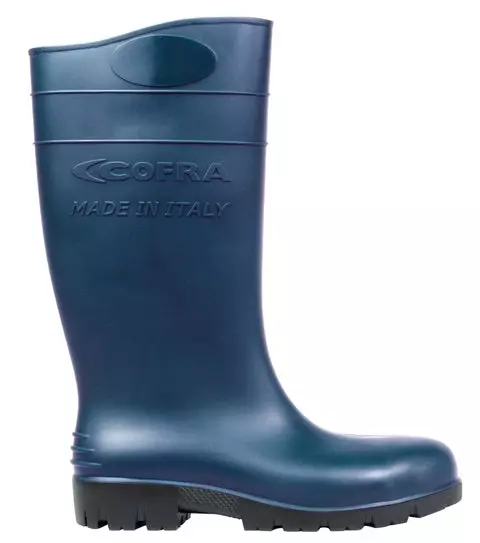Cofra Asteroid Blue S5 SRC Rain Boot
Cofra
visit storeProduct description
Product Features:
- Made of PVC ERGO-NITRIL
- Suitable for construction industry
- Outsole design:
— Wider standing surface for safe and comfortable walking
— Good mechanical and chemical resistance
— Good slip resistance with cleats for grip in longitudinal and transverse directions
- Non-slip, wave-shaped heel reinforcement for easy boot removal
Technical Details:
- Upper: PVC ERGO-NITRIL
- Outsole: PVC ERGO-NITRIL
- Footbed: EVANIT
— Made from EVA and nitrile mixture
— Variable thickness for high body support
— Thermoformed and perforated
— Breathable coating
— Antistatic due to conductive yarn
- Toe cap: Steel with 200 J toe protection
- Midsole: Stainless steel
- Width: 11 Mondopoint
Standards:
- S5 SRC EN ISO 20345:2011
Indicates the level of protective reinforcement, ranging from basic waterproof boots to safety-enhanced versions with additional guards and protective features.
The design and tread pattern of the boot's bottom, determining traction, slip resistance, and specialized protective features for different work environments.
The exterior color or finish of the boot, affecting visibility, style preferences, and how dirt or wear appears over time.
The color of the boot's bottom sole, affecting the overall appearance and coordination with the upper boot design.
The material used for the inner lining of the boot, affecting comfort, warmth, moisture management, and how the boot feels against your foot.
The material used in the protective toe cap, determining the level of impact protection, weight, and safety compliance for hazardous work environments.
- Cold Protective
- Slip Resistant
- Water Resistance
- Electrical Protection
Request a free sample
Test first and buy later. Visit any product page to request your free sample.
Standards and labels
Test results
General Requirements CIThe CI designation in the standard EN ISO 20345:2011 refers to the insulation performance of footwear against cold. This specification indicates that the footwear offers insulation against cold conditions, protecting the wearer's feet from low-temperature environments. The test method for determining this involves measuring the temperature decrease inside the footwear when exposed to cold conditions over a specified period. This performance is crucial for footwear used in conditions where exposure to cold is significant, ensuring safety and comfort for the wearer in such environments. The practical implications for safety footwear in this category include enhanced worker safety and performance in cold climates, applicable to industries such as construction, cold storage, and outdoor operations in winter conditions.
General Requirements S5The General Requirements S5 result in the EN ISO 20345:2011 standard identifies that the product has met specific safety criteria defined under category S5. This includes all the requirements for safety footwear made from ruber or polymeric that include, among other factors, the footwear having 200 joules toe cap, fully enclosed heel, antistatic protection, energy absorption of seat region, penetration resistant midsole, and having cleated outsoles. The S5 specification in this standard confirms adherence to rigorous testing protocols that assess these features. The test method involves subjecting the footwear to simulated conditions that evaluate their resistance to water penetration and absorption, along with measuring the performance of outsoles on various surfaces to ensure they meet the minimum requirements for safety in different working environments. The practical implication of this result is that the footwear is suitable for environments where contact with water is frequent and where enhanced grip and durability are necessary, thereby assuring the safety and comfort of the wearer in challenging conditions.
General Requirements CRThe standard EN ISO 20345:2011 encompasses general requirements for safety footwear to ensure they provide adequate protection in various occupational environments. Rating 'CR' signifies that the footwear has a cut resistant upper ensuring enhanced protection. The test method involves assessing the material's resistance to splitting or cracking under certain conditions, which simulates real-world industrial hazards involving sharp objects or surfaces. Practically, this result ensures that the footwear is suitable for environments where there is a risk of materials splitting or getting caught, thereby providing essential safety benefits to the user.
EN ISO 22568-3:2019 is a standard that sets out the requirements for testing and evaluating the gas tightness of industrial valves. It includes test methods and performance criteria for measuring the tightness of valves when they are closed and under different pressure and temperature conditions. Possible test results include data on the valve's ability to prevent gas leakage and maintain its seal under varying conditions.
EN ISO 22568-1:2019 is a standard that sets out the requirements for the design, manufacturing, and testing of industrial valves. It specifies the performance requirements for valves such as pressure rating, temperature range, and leakage rate. Testing methods are also outlined in the standard, and test results should demonstrate that the valve meets the required specifications.
REACH stands for "Registration, Evaluation, Authorisation and Restriction of Chemicals" it is a regulation of the European Union that governs the registration, evaluation, authorization, and restriction of chemicals. The REACH regulation aims to ensure that the chemicals used in Europe are safe for human health and the environment. The regulation applies to all chemical substances, whether they are used in industrial processes or in everyday products such as cleaning products, paints, and cosmetics. Companies that manufacture, import or use chemicals in the EU must register the chemicals they produce or import, provide safety information and communicate the risks associated with the chemicals. This information will be used to assess the risks and determine if any further action is needed to protect human health and the environment.
CE Marking is a label that shows a product meets certain safety and environmental standards set by the European Union. To get the CE Marking, a company must test and certify their product meets these standards. CE Marking is required for many products sold in the EU, including electronics, machinery, toys and medical devices. It helps ensure that products are safe for consumers and the environment, and allows for easy trade within the EU.
PPE stands for "personal protective equipment." PPE Category 2 refers to equipment that is more complex, and has a higher level of risk. Examples of PPE Category 2 include safety helmets, ear protection, and fall arrest equipment. In Europe, PPE Category 2 must meet certain safety standards set by the European Union, which means that it must be designed and manufactured to protect the user without causing harm. Companies that make or sell PPE must prove that it meets these standards. They also must have a quality management system in place and have to be audited regularly by a notified body.
Cofra delivery terms
Free delivery when you order more than 150,00 € from Cofra
Supplier shipping fee 6,68 €
Brand minimum 0,00 €
Price available on request
Shipping fee is 6,68 € for orders under 150,00 €
Sold in units of one pair
Need larger quantities?
Other products you may like
Recently viewed
Need help?
Get help from our experts
Other products you may like
Similar products you may like
Autonomous sourcing platform
The most efficient way to source and order supplies for your operations
Sourcing
Ordering
List products you’re looking for and we’ll find the best products and prices for you – all for free.
Need help?
Get help from our experts



